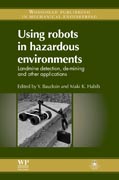
There have been major recent advances in robotic systems that can replace humans in undertaking hazardous activities in demanding or dangerous environments. Published in association with the CLAWAR (Climbing and Walking Robots and Associated Technologies) Association (www.clawar.org), this important book reviews the development of robotic systems for de-mining and other risky activitiessuch as fire-fighting. With its distinguished editors and international team of contributors, Using robots in hazardous environments: landmine detection, de-mining and other application will be a standard reference for all those researching the use of robots in hazardous environments as well as government and other agencies wishing to use robots for dangerous tasks such as landmine detection and disposal. Professor Yvan Baudoin is Head of the Department of Mechanics at the Royal Military Academy, Belgium. Professor Baudoin is also Chair ofthe HUDEM (Robotics Assistance in Mine Clearing) and RISE (Risky Interventionand Surveillance of the Environment) Working Groups within the International Advanced Robotics Progam (IARP). Dr Maki K. Habib is Professor of Robotics andMechatronics in the Department of Mechanical Engineering at The American University in Cairo, Egypt. Professor Habib is also a member of various Working Groups within IARP. INDICE: Part 1 Humanitarian demining: The evolution of robots and the challenges: Introduction: Mobile robotics systems for humanitarian de-mining and risky interventions; Robot for non-conventional demining process: from remote control to autonomy; Locomotion and localisation of humanitarian demining robots; Sustainable and appropriate technologies for humanitarian demining; Some problems of robotic humanitarian demining evolution. Part 2 Sensors for mine detection and robotics: Sensing capabilities for mobile robotics; Sensor fusion for automated landmine detection on a mobile robot; Relating soil properties toperformance of metal detectors and ground penetrating radars; Contribution ofgeophysics for landmines and UXO detection: Case study in the Egyptian environment; Detecting landmine fields from lowresolution aerial infrared images; GPS data correction using encoders and INS sensors. Part 3 Autonomous and teleoperated robots for humanitarian demining: Environment-adaptive antipersonnel mine detection system: Advanced mine sweeper; Mechanical mine clearance: Development, applicability and difficulties; Robotic tools for demining and risky operations; RAVON — The robust autonomous vehicle for off-road navigation; Aid ofcomputer training in handling with ground teleoperated robots for demining. Part 4 Robot autonomous navigation and sensors: A fuzzy-genetic algorithm and obstacle path generation for walking robot with manipulator; Synthesis of a sagittal gate for a biped robot during single support phase; Fuzzy logic control in support of autonomous navigation of humanitarian demining robots; Human victim detection and stereo-based terrain traversability analysis for behavior-based robot navigation; Simulation of a mobile multilink robot with vision virtual reality system; Estimation of the distance by using the signal strength forlocalization of networked mobile sensors and actuators. Part 5 Multi roboticssystems: Navigation and cooperation; Experimental study on the effects of communication on cooperative search in complex environments; Mobile ad-hoc networking supporting multi-hop connections in multi-robot scenarios; A decentralized planification architecture for a swarm of mobile robots; NVIDIA CUDA application in the cognitive supervision and control of the multi robot system methodology for the supervision and control of the multi robotic system with CUDA application; Laser based cooperative multi-robot map building for indoor environments; Heterogeneous multi-agent system behaviour patterns for robotics applications; A light-weight communication protocol for tele-operated Robots in risky emergency operations.
- ISBN: 978-1-84569-786-0
- Editorial: Woodhead
- Encuadernacion: Cartoné
- Páginas: 704
- Fecha Publicación: 01/08/2010
- Nº Volúmenes: 1
- Idioma: Inglés
